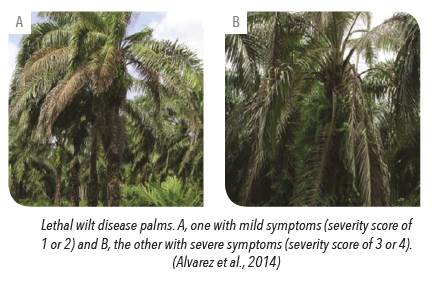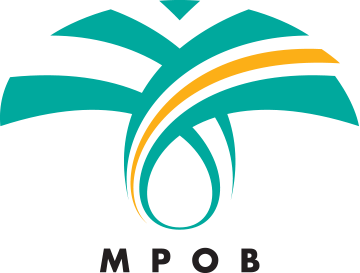General Information

Symptoms of lethal wilt usually first appear as vascular discolouration and leaf yellowing when the palm is mature (i.e., flowering and fruiting) at seven years old. These symptoms are followed by leaf drying, wilt, and necrosis of infected tissues, and eventual plant collapse. Root necrosis often accompanies leaf discolouration. Internal discolouration of trunk tissue may also occur but does not represent a distinctive symptom. Lethal wilt is potentially destructive because it spreads rapidly and causes plant death within 4 to 6 months after symptoms first appear. The pathogen was believed to be a phytoplasma, possibly related to that associated with lethal yellowing disease, which infect other palms such as coconut. Phytoplasmas have been associated with diseases in several hundred plant species. They are limited to the plants’ phloem tissue, and to insect vectors that feed directly from phloem tissues. Vectors include planthoppers and leafhoppers in the genera Macrosteles, Euscelis, Euscelidius, and Scaphoideus, Cacopsylla. Phytoplasmas are associated not only with lethal yellowing in coconut palms in many parts of the world, but also with diverse palm species.
Worldwide this disease affects at least 30 species of palm, including Phoenix dactylifera (date palm), Veitchia merrilli (manila palm), Caryota rumphiana (fishtail palm), Phoenix canariensis (Canary Island date palm), and Elaeis guineensis (African oil palm) (39,40). The disease has killed millions of coconut palms (Cocos nucifera) throughout the Caribbean, Florida, Mexico, and Central America.
Distribution
Africa, Latin America.
Detection and Inspection
Phytoplasma identification and classification rely on 16S ribosomal gene analysis to identify Candidatus Phytoplasma asteris species and distinguish between the 16Sr groups and subgroups. In particular, Candidatus Phytoplasma asteris is classified in the 16SrI group, in which at least 18 subgroups are recognised. Finer differentiation can also be obtained by studying polymorphisms on other genes in order to monitor the spread of specific Phytoplasma strains.
Prevention and Control
PHYTOSANITARY
The import of germplasm material (seeds, pollen, tissue culture) must be accompanied by an import permit issued by or on behalf of the Director-General Department of Agriculture for Peninsular Malaysia (including Labuan), or the Director Department of Agriculture for Sabah, and a phytosanitary certificate issued by an authorised official from the country of export. The import conditions are available upon request from the Plant Biosecurity Division Malaysia. All consignments are subjected to inspection by the Department of Agriculture prior to clearance by Customs. Germplasm material imported from high risk areas should be sent for third country quarantine before arrival onto Malaysian shores.
CULTURAL CONTROL AND SANITARY METHODS
Best control is to plant resistant varieties. Insecticidal control of vectors / potential vectors (i.e. planthoppers) can limit the spread of the disease.
Further reading
- Alvarez, E; Mejía, J F; Contaldo, N; Paltrinieri, S; Duduk, B and Bertaccini, A (2014). ‘Candidatus Phytoplasma asteris’ strains associated with oil palm lethal wilt in Colombia. Plant Dis. 98: 311-318.
- CABI Invasives Species Compendium (2014). Candidatus Phytoplasma palmae (lethal yellowing of coconut). Url: http://www.cabi.org/isc/datasheet/38647.
- CABI and EPPO (2014). Palm lethal yellowing Phytoplasma. URL: http://www.eppo.int/QUARANTINE/ data_sheets/bacteria/PHYP56_ds.pdf.
- Sullivan, M and Harrison, N (2013). CPHST Pest Datasheet for ‘Candidatus Phytoplasma palmae’ and related strains. USDA-APHIS-PPQ-CPHST. Revised June, 2014.
- Smith, N (2015). Palms and People in the Amazon. Springer International Publishing: Switzerland. 231 pp.

